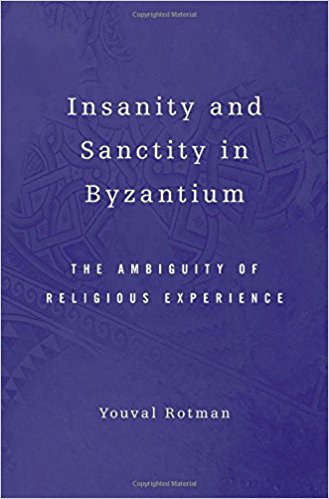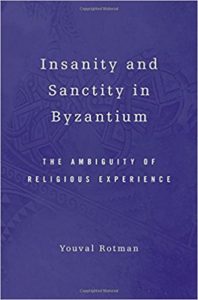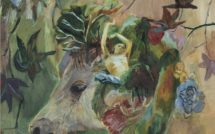
 Societies organize the world of lived experience along a wide spectrum of normative polarities. As the cultural pendulum moves from one direction to the other, we experience a radicalization of values because the amplification of convictions on one end triggers reactions on the other. Construed as polar opposites in popular imaginaries since the Enlightenment, religion and secularism have generated different anthropologies and modes of being. Depending on our epistemological position and outlook on the spectrum of political theology, we may ascribe different valences to the same phenomenon: insanity or sanctity, profane or sacred, real or illusory.
Societies organize the world of lived experience along a wide spectrum of normative polarities. As the cultural pendulum moves from one direction to the other, we experience a radicalization of values because the amplification of convictions on one end triggers reactions on the other. Construed as polar opposites in popular imaginaries since the Enlightenment, religion and secularism have generated different anthropologies and modes of being. Depending on our epistemological position and outlook on the spectrum of political theology, we may ascribe different valences to the same phenomenon: insanity or sanctity, profane or sacred, real or illusory.
Youval Rotman’s Insanity and Sanctity in Byzantium, addresses the basic anthropological polarity that the Byzantine holy fool (salos in Greek) posed to culture and society confronted with extreme behaviors. He provokes his modern readers by introducing them to people who walk naked in the streets of bustling cities, martyrs willingly embracing death, and ascetics refusing to eat anything but grass in order to escape the constraints of materiality. Precisely because the holy fools are so uncanny, their social performances compel us to observe and diagnose not only Byzantine categories of deviance, but also our own analytical and epistemological notions about religious sanctity and mental pathology. If we choose to follow Rotman’s lead to the end, we come away having assembled a historical-psychoanalytical matrix with which we could measure and evaluate fissures in normative social and psychological structures and experiences.
The specifics of Rotman’s theoretical argument are broken into two parts; each part consists of two chapters. Part I, “Sanctified Insanity: Between History and Psychology,” outlines his broad framework, the objective of which is to find an analytical equilibrium between religious studies, history, and psychology. Rotman implicitly suggests that when we combine the three disciplines together, the gain is not so much that we resolve all of the inherent contradictions in our cognitive universe, but that we understand better the nature of our projections and transferences. What is more, we begin to dissect how history and society shape our ideation, apperception, and normalized consciousness.
Following along Rotman’s analysis, we realize that we are taught to imagine madness as something beyond the limits of our socially and psychologically-constructed standards of normality. It is a sensitive space where only doctors are allowed to go. Sanctity, on the other hand, leads us into these very psychological places that we would otherwise consider “mad,” or “abnormal.” Thus, the “mad” man and the “holy” man are posed at the polar opposites of ontology: the secular and the religious. Throughout the book, Rotman follows and occasionally intersects the horizontal line of secular psychoanalysis and history with the vertical line of religion and sanctity to chart out the dialectic between personal apperception and social change. Change, like the behavior of holy fools, is jolting and disruptive. At these moments of crisis and fear, religion refracts social trepidation into awe; it normalizes the extremes of social change. Suddenly, the disruption is seen as revelation, relief, and normalization. If we imagine a graph, we would mark this point as an intersection between the two axes of the secular and the religious, an equilibrium between the ontological opposites based on belief or disbelief in God.
Chapter 1, “The Paradox that Inhabits Ambiguity,” introduces the etymological ambiguity of the Greek word salos. Rotman explains that already in the fifth century, when the word became prominent, salos designated both a madman and a religious person who faked madness in order to reach the spiritual heights promised by the apostle Paul, who preached for the subversion of philosophical materialism (11-12). The paradox of the holy fool, we are told, is in the epistemological uncertainty about the underpinning motivations behind the outward, shocking behaviors (29). Is it “real” psychological disorder, or faked madness? The paradox is resolved in Chapter 2.
“Meanings of Insanity,” the title of Chapter 2, unties the paradox of the holy fool by exposing the social utility of the phenomenon. Rotman turns to Sigmund Freud and Viktor Shklovsky for helpful insights. He invokes the concept of “defamiliarization” or ostranenie in Russian, a peculiar mental state in which we step out of ourselves to gain completely new insights into “the familiar.” In the process, the old self is reconfigured to see different forms of consciousness and to share “a new perception of reality” (62). “Regardless of its own objectives as a literary figure, it [the figure of the holy fool] aims to construct insanity as a mirror in order to bring about a collective change” (77). By compelling us to defamiliarize ourselves (i.e., to gain a new perspective), the holy fool forces us to change.
Part II, “Abnormality and Social Change: Early Christianity versus Rabbinic Judaism,” unfolds the ways in which this collective change is played out in social reality. In Chapter 3, “Abnormality and Social Change,” Rotman takes us into the world of rabbinic Judaism and early Christianity to examine the different ways in which each religious tradition applied the psychologem of the martyr. While Judaism resisted any social change, Christianity embraced the martyr as a trope with which it could institute a radical change in its teachings and practices. The general argument is that religious categories sanitize abnormality and transform it into a new conceptualization of sacred reality. Chapter 4, “Socializing Nature,” reframes the Christian ascetic as a “dynamic religious totem.” Following Émile Durkheim, Rotman sees the ascetic as a way “to connect the natural and the cosmological with the social” (129). In other words, the literary trope of the ascetic functions as a type of collective effervescence, a compression of social energy that defines the sacred (totem) and, by contrast, the profane (taboo). With the totemic, the ascetic bestows upon us an entire cosmology, ordered hierarchically from the sacred down to the profane. It reverberates in society to orchestrate the natural order of things.
The books ends by reminding us that holy foolery, asceticism, and martyrdom should not be read as Freudian neuroses, but as positive phenomenologies that make us look beyond the pale of normativity. Extreme religious behaviors are complex psychohistorical phenomena that disrupt propriety and, by virtue of their spirituality, convert abnormality into sanctity…And perhaps even more, for Rotman seems to be inviting us to consider religion as a shock therapy for all disrupted societies that find themselves in a dire need of re-articulated mythologies.
Rotman’s main contribution is his application of a variety of theories to extrapolate new meaning from familiar sources. Rather than definitive resolutions of historical and social problems and issues, he emphasizes ambiguity of experiences and their affective influences upon the subject and the observer. Ambiguity is also Rotman’s lens that transfigures madness into a personal, even intimate dialogue with the other side of ourselves. “Where do we draw the line between normal and abnormal behavior?,” Rotman asks, “And what is the place of individual abnormal behavior in the social fabric especially in situations when the individual’s behavior disturbs the social?” (2).
To answer these general and philosophical questions, we are placed in front of the cultural mirror of Byzantium where our perceptions of the Byzantines and of ourselves suddenly break and refract as a myriad of ambiguous images and imaginaries. The startling, alarming, or aw(e)ful behaviors of babbling people casting dirty words or objects at crowds or random passersby change their shades from insanity to holiness based on our openness to “transform the language of normal or accepted communication into a different kind of communication” (176). As is clear from Rotman’s very first pages, he situates his book in the crevices between history, psychology, and religious studies—imperfect (as he admits himself ) by the individual standards of each discipline, but promising and bold in its venture to chart out a new analytical space for psychohistory, or “our understanding of psychological processes as social phenomena” (6-7).
From the introduction onward, Rotman quickly whisks us away from Byzantium and into the literary and philosophical cosmologies of Mikhail Bakhtin, Michel de Certeau, Michel Foucault, Victor Turner, Sigmund Freud, Donald Winnicot, and Antonin Artaud (to name only but a few of the theoreticians who probe into holy foolery just as much as they probe into us). Shaped by these and other modern and postmodern theoreticians, Rotman’s hermeneutics demand that we read the hagiographies of holy fools, ascetics, or martyrs not only as “literature in their time (rather than “of their time”) but also as literature in our time” (51). His emphasis is on the transformative nature of reading, a psychohistorical dialectic that dynamically shapes all of our experiences and thus denaturalizes our encounters with “sanctity” or “insanity.” There is a powerful interaction between what we read, how we feel, and what we see because reading is indeed transformative.
In Rotman’s analysis, the main utility of religion (if not its very essence) is to sanctify abnormality so that it may transform the social environment (179). It is a shock therapy, so to speak, not by generating radical changes in the economic structure of society as Marx prescribed in his model of historical determinism, but by rearticulating the cultural memes and mythologies of society. In other words, Rotman depicts a process of inflecting cultural deviance with holiness. Thus, while modern psychology seeks to operationalize and cure abnormality, Rotman suggests, religion thrives in the blurry lines between sanity and insanity. We are told that religion is uniquely equipped to relieve the anxieties of social change because it masks the inherent ambiguities and uncertainties with saintliness and holiness.
Dense and abstract, Youval Rotman’s Insanity and Sanctity in Byzantium is a book likely to appeal more to the theoretician than to the Byzantinist. His rich collage of theories, spanning from psychology to literary criticism and from sociology to theater studies, is indeed stimulating and exciting even if Byzantium and its own philosophers, psychologists, and social theorists are altogether overshadowed by their modern and postmodern counterparts. Still, the author has charted a new analytical space for us through his composite of history, psychology, and religious studies. For those who choose to follow Rotman and embrace theory, my suggestion is to put the Byzantine and (post-)modern thinkers in a direct conversation with one another, a difficult task, of course, but one that promises timely prescriptions and lessons from the Byzantines for our own culture and society bedeviled by disruptive and pain-inducing ambiguities of insanity and sanctity.
Reviewed by Alexander Angelov, The College of William and Mary
Insanity and Sanctity in Byzantium: The Ambiguity of Religious Experience
by Youval Rotman
Harvard University Press
Hardcover / 272 pages / 2016
ISBN: 9780674057611
To read more book reviews, please click here.
Published on April 4, 2017.




